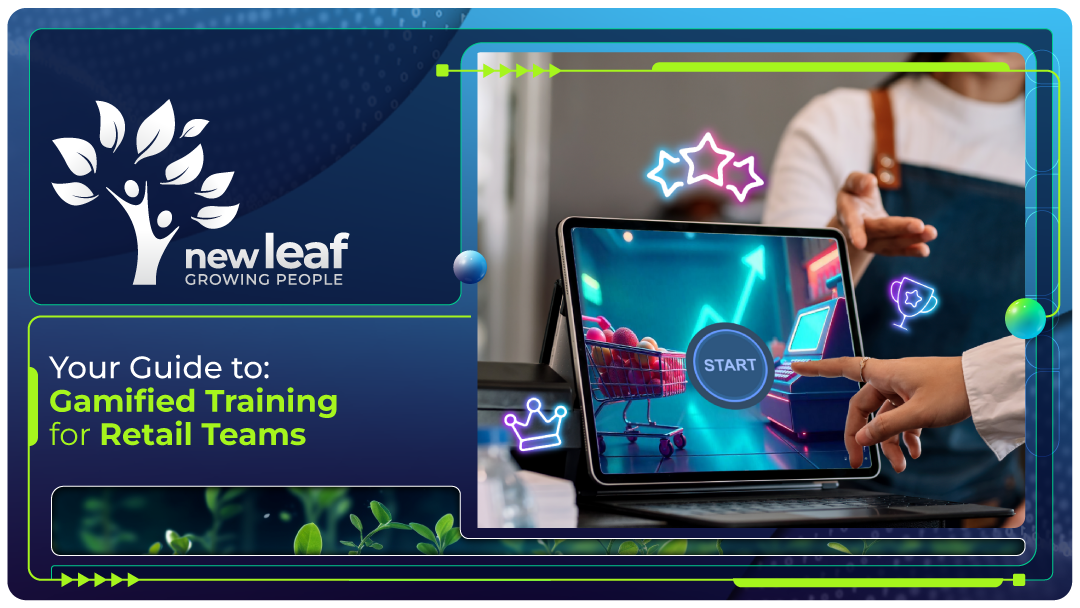
Keeping employees engaged in training can be challenging in today’s fast-paced retail environment. All too often, traditional training methods lead to low retention and disinterest. But what if learning felt more like playing a game? This guide to gamified training for retail will explain how it’s done.
According to TalentLMS’s Gamification at Work Survey, gamification has a clear impact on employee motivation and satisfaction:
- Employees retain 22% more information from gamified training.
- 83% of those who receive gamified training feel more motivated.
- 33% would prefer more game-based learning features.
In short, gamification enhances training, and employees want more of it. By integrating game-like elements into training, retail companies can transform mundane lessons into exciting, interactive experiences.
Let’s explore gamification, why it works for retail staff, and how New Leaf Technologies makes it easy to implement.
What Is Gamification?
Gamification mastermind Yu-kai Chou, author and international keynote speaker on gamification and behavioural design, puts it simply: “Gamification is the craft of deriving all the fun and engaging elements found in games and applying them to real-world or productive activities.”
In essence, it applies game mechanics — such as progress bars, points, badges, leaderboards, and challenges — to non-game contexts. Instead of passive learning (reading, watching, and listening), employees engage in interactive, competitive, and rewarding experiences.
Key Gamification Elements You Can Use in eLearning:
- Points & incentives: Learners score points and earn rewards for completing modules or quizzes.
- Badges & achievements: These help to recognise learner milestones (e.g., “Customer Service Pro”).
- Leaderboards: Friendly competition motivates high performance.
- Scenario-based challenges: Simulate real-world situations (e.g., how to handle a difficult customer).
The integration of artificial intelligence (AI) into gamification is an exciting development. AI is revolutionising the field, enabling more personalised, adaptive, and practical experiences for learners. AI-driven gamification uses machine learning (ML) and predictive analytics to analyse learner behaviour and preferences in real time, automatically adapting challenges and rewards to create personalised experiences at scale. For example, it can adjust quiz difficulty and recommend eLearning content based on each learner’s strengths and performance.
Why Gamification Works for Retail Training
Gamification done right is an excellent way to upskill your employees in the retail space, from sales staff and customer support to merchandisers and store managers. That’s because gamified learning:
- Boosts engagement and motivation
Retail training can be tedious, but gamification turns learning into an entertaining, rewarding experience. Learners stay motivated by earning rewards and engaging in friendly competition with peers.
- Improves knowledge retention
Interactive quizzes, simulations, and instant feedback help learners retain information better than passive lectures or manuals.
- Encourages adoption of new processes
Introducing new POS systems or store policy? Gamified training reduces resistance by making learning feel like an achievement, not a chore.
- Provides a safe space to learn from mistakes
Scenario-based games let employees practice real-world situations (e.g., handling returns, upselling) without real-world consequences.
- Tracks performance and identifies skill gaps
Gamified LMS platforms provide real-time analytics, helping managers see who excels and who needs extra support.
How We Simplify Gamification in Retail Training
Implementing gamification doesn’t have to be complicated. New Leaf Technologies’ eLearning solutions, such as TalentLMS and Moodle, make it easy to incorporate gamification into retail employee training. Key features include:
- Pre-built gamification templates: Ready-to-use leaderboards, badges, and quizzes.
- Mobile-friendly learning: Learners can train anytime, anywhere, on the sales floor or at home.
- Customisable challenges: Tailor scenarios to your retail brand (e.g., fashion, electronics, or groceries).
- Progress tracking: Monitor engagement and completion rates with ease.
While all this sounds exciting, the Center for Behavioral Decisions cautions that gamification is more than just play. It’s behavioural design, and great design works with human behaviour, not against it. To create engaging training modules that work, it’s best to follow these three guidelines:
- Start with straightforward challenges and gradually increase complexity to keep learners engaged and build confidence.
- Provide a safe space for learners to make mistakes, allow retries, and emphasise learning from errors.
- Give instant feedback, whether it’s a congratulatory message or corrective guidance, to reinforce learning.
These points are echoed in a study on the Effectiveness of Gamification in Enhancing Learning and Attitudes, where researchers used Articulate 360 software to prepare gamified content. Learners who felt they received good feedback and were appropriately challenged by the material tended to learn more and have a more positive attitude toward learning difficulty, value, and cognitive competency than the control group.
Gamified Training for Retail in Action
Here’s an example of how gamification can be applied to train employees in a tech retail store using a learning management system (LMS):
Scenario: Training Staff on a New Line of Smartphones
Training Objective
Ensure employees can confidently explain and compare the features of a new range of smartphones, handle common customer objections, and recommend the right product.
Gamified LMS Experience
- Mission-based learning:
Learners complete missions like “Camera Showdown” or “Battery Life Battle,” where they compare smartphone specs. Each mission completed earns XP (experience points). - Interactive quizzes with instant feedback:
After each module, learners take short quizzes (e.g., “Which phone supports wireless charging?”). Instant feedback helps reinforce learning and correct mistakes in a low-stress way. - Branching scenarios:
Learners play through simulated customer interactions (e.g., a parent buying a phone for a teen, or a business traveller looking for long battery life). Their choices affect the outcome, and they are awarded points for the best customer-focused answers. - Leaderboards and progress badges:
A store-wide leaderboard tracks the top learners, and they can unlock badges like “Tech Expert” or “Smartphone Specialist” by completing product lines or passing with high scores. - Daily challenges and microlearning:
To stay sharp, learners can take part in quick daily challenges (e.g., “Name three phones under $500 with 5G.”). These take two or three minutes, and keep learning continuous and engaging. - Rewards and recognition:
Top performers may receive digital certificates, recognition in team meetings, or even retail incentives like early access to staff discounts.
Gamified learning spectrum from individual to collaborative experiences

Outcome
Through gamified training, employees absorb technical information more effectively and practice real-world selling scenarios. The competitive and interactive format boosts confidence, product fluency, and customer service. It leads to better sales for business owners, as customers feel more secure in their purchasing decisions and are more likely to return.
Other Effective eLearning Strategies for Retail Staff
While gamification is powerful (Statista reports that 46% of US training industry respondents plan to invest in games and simulations), it’s even more effective when combined with other modern training methods, such as:
- Microlearning: Bite-sized lessons provide quick, on-the-job training.
- Asynchronous learning: Allows employees to engage with content on their own schedule, within a set timeframe.
- Mobile learning: Provides anytime, anywhere access to training, including just-in-time learning modules such as new product launches.
- Scenario-based learning: Simulates situations like dealing with an angry customer or guiding someone through a big purchase decision.
- Social and peer learning via discussion boards or chat features: Encourages knowledge-sharing and collaboration among learners.
Final Thoughts: Level Up Your Retail Training
Gamification isn’t just a trend; it’s a proven way to make training engaging, effective, and enjoyable for retail teams. With New Leaf Technologies, implementing gamified eLearning is simple, scalable, and impactful.
Ready to transform your retail training? Explore NLT’s solutions today and turn learning into a winning game!




